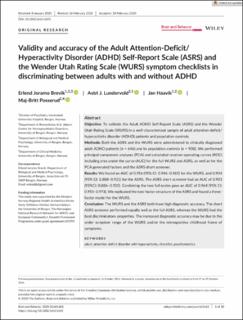| dc.contributor.author | Brevik, Erlend Joramo | |
| dc.contributor.author | Lundervold, Astri J. | |
| dc.contributor.author | Haavik, Jan | |
| dc.contributor.author | Posserud, Maj-Britt Rocio | |
| dc.date.accessioned | 2021-03-01T14:00:25Z | |
| dc.date.available | 2021-03-01T14:00:25Z | |
| dc.date.created | 2021-01-22T17:08:39Z | |
| dc.date.issued | 2020 | |
| dc.identifier.issn | 2162-3279 | |
| dc.identifier.uri | https://hdl.handle.net/11250/2730982 | |
| dc.description.abstract | Objective
To validate the Adult ADHD Self‐Report Scale (ASRS) and the Wender Utah Rating Scale (WURS) in a well‐characterized sample of adult attention‐deficit/hyperactivity disorder (ADHD) patients and population controls.
Methods
Both the ASRS and the WURS were administered to clinically diagnosed adult ADHD patients (n = 646) and to population controls (n = 908). We performed principal component analyses (PCA) and calculated receiver operating curves (ROC) including area under the curve (AUC) for the full WURS and ASRS, as well as for the PCA generated factors and the ASRS short screener.
Results
We found an AUC of 0.956 (95% CI: 0.946–0.965) for the WURS, and 0.904 (95% CI: 0.888–0.921) for the ASRS. The ASRS short screener had an AUC of 0.903 (95%CI: 0.886–0.920). Combining the two full scales gave an AUC of 0.964 (95% CI: 0.955–0.973). We replicated the two‐factor structure of the ASRS and found a three‐factor model for the WURS.
Conclusion
The WURS and the ASRS both have high diagnostic accuracy. The short ASRS screener performed equally well as the full ASRS, whereas the WURS had the best discriminatory properties. The increased diagnostic accuracy may be due to the wider symptom range of the WURS and/or the retrospective childhood frame of symptoms. | en_US |
| dc.language.iso | eng | en_US |
| dc.publisher | Wiley | en_US |
| dc.rights | Navngivelse 4.0 Internasjonal | * |
| dc.rights.uri | http://creativecommons.org/licenses/by/4.0/deed.no | * |
| dc.title | Validity and accuracy of the Adult Attention-Deficit/Hyperactivity Disorder (ADHD) Self-Report Scale (ASRS) and the Wender Utah Rating Scale (WURS) symptom checklists in discriminating between adults with and without ADHD | en_US |
| dc.type | Journal article | en_US |
| dc.type | Peer reviewed | en_US |
| dc.description.version | publishedVersion | en_US |
| dc.rights.holder | Copyright 2020 The Authors. | en_US |
| dc.source.articlenumber | e01605 | en_US |
| cristin.ispublished | true | |
| cristin.fulltext | original | |
| cristin.qualitycode | 1 | |
| dc.identifier.doi | 10.1002/brb3.1605 | |
| dc.identifier.cristin | 1877457 | |
| dc.source.journal | Brain and Behavior | en_US |
| dc.source.40 | 10 | |
| dc.source.14 | 6 | |
| dc.identifier.citation | Brain and Behavior. 2020, 10 (6), e01605. | en_US |
| dc.source.volume | 10 | en_US |
| dc.source.issue | 6 | en_US |

